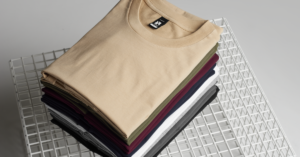Sure, there are many terms that succinctly explain different approaches to textile printing – think ‘hand block printing’, ‘roller printing’, ‘cylinder printing’ and ‘stencil printing’. However, you might not know exactly what these techniques entail.
It’s understandable to be confused, but also useful to know where the differences lie. That way, you can more easily judge which technique would be best for the custom clothing that you seek for personal or business purposes. Here, we throw the veil off an in-depth guide to textile printing methods.
Hand block printing
The history of textile printing can be traced as far back as Chinese antiquity, from when the oldest surviving examples of textile printing originated. As far as can be gathered, it all started with woodblock printing, where wooden blocks would be applied by hand to imprint designs.
Those designs could comprise text, images or patterns. Unsurprisingly in light of the technological advances in textile printing over the centuries, this tried-and-tested method has come to be alternatively known as hand block printing. It’s also a technique that has artistic merit even today.
For capturing particularly artistic results, woodblock printing can prove more effective than other means of textile printing. However, it’s also a slow and laborious process to undertake personally.
Engraved copperplate printing
You might think you understand what engraving is. As you probably imagine, it involves incising imagery onto a solid and typically flat surface. However, it might have escaped your knowledge that historically, a copperplate has often served as that surface.
Copperplate engraving had its genesis in the workshops of 15th-century goldsmiths. After making impressions on paper of images that they intended to have engraved on silver or golden plates, the goldsmiths realised that these images could be reproduced – using copperplates…
A copperplate engraver needed to work slowly and carefully to avoid making mistakes that would be impossible to correct on the copper. However, they would be rewarded with an engraving that would typically be more exquisitely designed than a woodcut.
Roller printing
It was not until 1770 that engraved copperplates were used in printing textiles for the first time. However, this practice is now a relic, having become wholly obsolete in the textile printing industry even before the Victorian period drew to a close.
The cost of copperplate printing for textile printing was a particularly heavy sting – and in an attempt to relieve that sting, Thomas Bell of Scotland patented a new procedure in 1783. That textile printing process is referred to today as roller printing or cylinder printing.
In the 1780s, Bell’s roller printing machine, which included six rollers each carrying part of the intended pattern, was used by the Lancashire-based textile business Livesey, Hargreaves and Company. This successful implementation ushered in the rising popularity of roller printing.
Perrotine printing
Although block printing has largely become redundant due to the much greater efficiency of roller printing, one type of block printing machine is still used, mainly in France, Germany and Italy: the perrotine. In the long history of machine printing, it remains the only practically successful block printing machine.
The perrotine was invented in 1834 and works by exerting three large blocks – each of which is cut or cast with its own pattern – on a printing table across which the cloth is brought.
However, for reasons that haven’t always been clear, the perrotine has been scarcely adopted in England – leaving this curiosity largely an irrelevance on British shores.
Stencil printing
Even if you have often used stencilling in various artistic ways, you might not have realised that it has been a method of decorating textile fabrics since ancient times. It was used by the Japanese before being increasingly adopted in Europe in the 19th century.
In preparation for carrying out stencil printing yourself, you would need to use a sharp-pointed knife to cut a pattern from a thin metal or stout paper sheet. The next stage would be to lay that sheet onto the fabric before you brush colour through the sheet’s gaps.
Although stencilling is straightforward in theory, the designs are somewhat limited due to the need for ‘ties’ to connect the patterns. For example, as it isn’t possible to cut a circular outline without losing its centre, some parts of the outline would need to be left uncut.
Screen printing
As we have seen in this article, there are many different kinds of textile printing. However, if you have never placed an order for custom printed clothing, screen printing could provide a particularly good introduction to textile printing.
One major reason why is that screen printing is easily the most commonly used textile printing technology today. Furthermore, we offer it as an option here at Garment Printing. Ink is applied to a screen from which, with the use of blades called squeegees, it is pushed onto the garment.
One variant of screen printing that we offer is called discharge screen printing. This technique uses water-based discharge ink to deactivate dyes on natural fabrics and leave a very soft print.
Our website lists various other screen printing options for which we offer competitive quotes. We can act on a quote request in less than 15 minutes during business hours!




